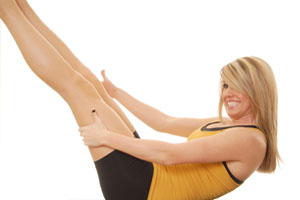5 Exercise Tips for Better Posture

“Good posture” is more than an indication of whether you paid attention as a kid when your parents admonished you to “Stand up straighter” or “Don’t slump your shoulders like that”. Posture is the position in which you naturally hold your body when you are standing, sitting, and even lying down. “Good posture” is when you do this while maintaining the correct alignment of your body parts, supported by the right amounts of muscle tension against the pull of gravity.
Most of us normally give no thought to our posture. Our muscles tend to “do it for us,” without us even thinking about it. The problem with this largely unconscious process is that over time our muscles can become weak or improperly trained to hold our bodies in less than an optimum position. This is bad because proper posture helps us to keep our bones in correct alignment so that their supporting muscles are used correctly. Proper posture also reduces stress on our ligaments, and helps to prevent muscle strain and overuse disorders. Improper posture can have many negative effects on our general health, including excessive strain on our postural-support muscles, reduced lung capacity and chronic back or neck pain.
There are many exercises that can help strengthen your postural-support muscles, but the best approach to take if you want to improve your posture in a more systematic way is to see your chiropractor. He or she can analyze your posture and then prescribe a customized set of exercises to restore strength and balance to your postural-support muscles. Your chiropractor can also make adjustments to your spine and other joints to eliminate abnormalities that encourage improper posture.
When using exercise to help improve your posture, it’s a good idea to follow a few simple guidelines.
- Focus first on core-strengthening exercises. That is, work to strengthen the sets of muscles around your waist and lower back, which do most of the work of maintaining proper posture. Don’t simply rely on old-fashioned “sit-ups,” however. Pilates, yoga, and the set of core-strengthening exercises recommended by the North American Spine Society are more effective, providing more benefits with less strain.
- Keep these core-strengthening exercises safe. Practice the single-leg lifts, crunches or “curl-ups,” and crossovers slowly and with controlled motions, avoiding the tendency to “overdo it.” Pull your abdominal muscles in (up and towards the spine) as you exercise, and breathe normally. Start with a low number of repetitions tailored to your current fitness level and increase the number only as you grow stronger.
- Perform shoulder and neck exercises to strengthen your upper body. Weak shoulder muscles are the most common cause of “slumped shoulders.” Also, stiff muscles in the neck and upper back can aggravate and perpetuate poor posture.
- Strengthen your hips and pelvis. Exercises such as anterior pelvic tilts strengthen your hip and butt muscles, which are essential to enabling you to stand and walk with correct posture.
- Don’t forget your feet. Good posture and a healthy musculoskeletal system start from the ground up. You should work with your chiropractor on this one, especially if he or she has indicated that you suffer from either “pigeon toes” or “duck feet,” meaning that your feet point at an angle either inward or outward, rather than straight ahead. Chiropractic adjustments can help to correct this, but there are also exercises that can strengthen your muscles to correct these conditions, and allow you to stand and walk more normally.